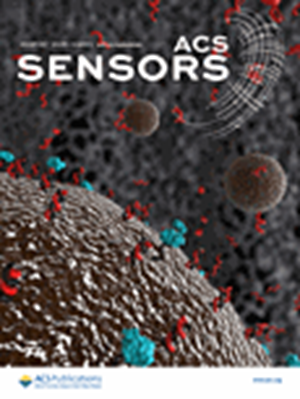可穿戴,透气,无线气体传感器使高选择性呼出氨检测和实时无创疾病诊断
IF 8.2
1区 化学
Q1 CHEMISTRY, ANALYTICAL
引用次数: 0
摘要
能够实时分析呼出气体的可穿戴气体传感器已被确定为无创疾病诊断的理想设备。然而,由于其固有的刚性和脆性以及高交叉灵敏度,传统半导体气体传感器在实现高灵活性、鲁棒性和选择性呼气分析方面面临重大挑战。在此,我们提出了一种可穿戴式气体传感器,通过将SnS2纳米片/聚苯胺(PANI)传感层原位锚定在渗透性和柔性氧化钇稳定氧化锆(YSZ)纳米纤维衬底上,用于分析呼出的NH3。YSZ网络的交联网格和SnS2纳米片之间丰富的空隙有效地释放了YSZ/SnS2/PANI薄膜中的应力集中,使传感器能够承受剧烈的折叠/弯曲变形。有机聚苯胺护套使YSZ/SnS2/聚苯胺基气体传感器具有增强的韧性(0.66 kJ·m-3)、稳定的电气连接和出色的鲁棒性。独特的质子化/去质子化传感机制,加上传感层的异质结效应,确保了出色的选择性(传感器免疫系数≈69%)和对NH3的高响应。为了支持可穿戴应用,来自可穿戴传感器的传感信号通过蓝牙无线传输,并显示在智能手机上。这项工作极大地推动了可穿戴半导体传感器在个人疾病诊断中的应用。本文章由计算机程序翻译,如有差异,请以英文原文为准。

Wearable, Breathable, and Wireless Gas Sensor Enables Highly Selective Exhaled Ammonia Detection and Real-Time Noninvasive Illness Diagnosis
Wearable gas sensors capable of real-time analysis of exhaled breath have been identified as ideal devices for noninvasive illness diagnosis. However, due to their inherent rigidity and brittleness, as well as high cross-sensitivity, conventional semiconductor gas sensors face significant challenges in achieving high flexibility, robustness, and selective exhaled breath analysis. Herein, we propose a wearable gas sensor by anchoring a SnS2 nanosheets/polyaniline (PANI) sensing layer in situ onto a permeable and flexible yttria-stabilized zirconia (YSZ) nanofiber substrate for the analysis of exhaled NH3. The cross-linked meshes of the YSZ network and the abundant voids between SnS2 nanosheets effectively release the stress concentration in YSZ/SnS2/PANI films, enabling the sensor to withstand severe folding/bending deformation. The organic PANI sheath endows the YSZ/SnS2/PANI-based gas sensor with enhanced toughness (0.66 kJ·m–3), stable electrical connection, and excellent robustness. The unique protonation/deprotonation sensing mechanism, coupled with the heterojunction effect of the sensing layer, ensures outstanding selectivity (sensor immunity coefficient ≈ 69%) and a high response to NH3. To support wearable applications, the sensing signals from the wearable sensor are transmitted wirelessly via Bluetooth and displayed on a smartphone. This work greatly advances the application of a wearable semiconductor sensor in personal disease diagnosis.
求助全文
通过发布文献求助,成功后即可免费获取论文全文。
去求助
来源期刊

ACS Sensors
Chemical Engineering-Bioengineering
CiteScore
14.50
自引率
3.40%
发文量
372
期刊介绍:
ACS Sensors is a peer-reviewed research journal that focuses on the dissemination of new and original knowledge in the field of sensor science, particularly those that selectively sense chemical or biological species or processes. The journal covers a broad range of topics, including but not limited to biosensors, chemical sensors, gas sensors, intracellular sensors, single molecule sensors, cell chips, and microfluidic devices. It aims to publish articles that address conceptual advances in sensing technology applicable to various types of analytes or application papers that report on the use of existing sensing concepts in new ways or for new analytes.
 求助内容:
求助内容: 应助结果提醒方式:
应助结果提醒方式:


